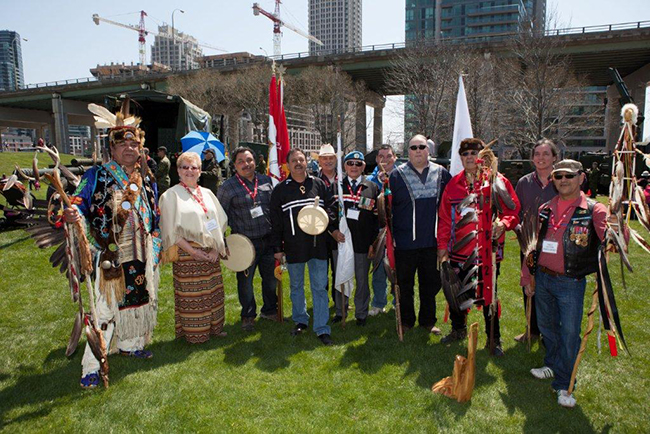Warriors honoured at York

By Brian Charles
TORONTO –As people gathered along the Toronto shoreline, waiting for the fire to be lit for a sunrise ceremony, birds offering their daybreak songs, and the morning fog lifting off the surface of Lake Ontario, participants must have been wondering what it was like on that April 27 morning, 200 years earlier.
On that day an American force of 2600 aboard 14 ships arrived from Sacket`s Harbor, New York to launch an all-out attack on Fort York.
After easterlies pushed their fleet off-course to about halfway between the Fort and the mouth of the Humber River, the Americans began disembarking and encountered York’s first defenders – about 80 Anishinaabe warriors, who were using the forest for cover.
In the heavy combat that followed, Chief Yellowhead from Rama was shot in the jaw, disfiguring him for life. This did not stop him from participating in battles on the Niagara frontier as the War of 1812 raged on a year later. It did, however, cause him to pass on the hereditary leadership of the Band to his son, William Yellowhead, shortly after the war.
This April 27’s sunrise ceremony welcomed several hundred people from many different communities, both First Nations and Toronto`s multicultural communities. A guided interpretive walk led participants back to Fort York to share the history of the battle, declared a victory for the invaders, although they suffered nearly as many casualties when the retreating British blew up the fort’s powder magazine.
Spectators at Queen’s Park later that morning saw Canadian Forces members parachuting and rapelling down buildings. His Royal Highness Prince Phillip presented new military colours to the Royal Canadian Regiment, of which he is the Honourary Colonel-in-Chief. This was followed by a march to Fort York by 1700 members of the Canadian Forces, which was billed as the largest military parade through the streets of Toronto since the end of World War II.
At the day’s closing ceremonies, Chiefs of the Mississaugas of New Credit, Beausoleil, Chippewas of Georgina Island and Chippewas of Rama First Nations assisted the Honourable David Onley, the Queen’s representative as Lieutenant-Governor for Ontario, in unveiling a commemorative plaque. The plaque will be on permanent display at Fort York, and honours the contributions of First Nations people in the War of 1812. It features an image of the Treaty of Niagara Covenant Chain Wampum, which was given to the Western Great Lakes Confederacy in 1764 by the British to confirm the terms of the previous year’s Royal Proclamation.
Chief Donna Big Canoe of the Chippewas of Georgina Island reminded spectators that First Nations were Allies of the Crown, not merely subjects. Speaking on behalf of Chief Roland Monague, Councillor Jeff Monague of Beausoleil First Nation brought a message of appreciation that the contribution of our ancestors was being honoured. Councillor Monague also reminded the gathering that promises were made to create the alliance between the Crown and First Nation peoples, and that many of those promises have still not been realized. Chief Sharon Stinson-Henry spoke on behalf of the citizens of the Chippewas of Rama.
Chief Sharon Stinson-Henry of the Chippewas of Rama said: ‘This Bicentennial commemoration will now form part of the history curriculum for Canada’s young students. It is important to recognize and understand the role our Anishinaabe ancestors played in building, defending and shaping our home and native land, Canada, and that it is a part of the story and true history of this great country.”
She also took time to acknowledge the presence of Vernon Yellowhead and Emerson Benson-Nanigishkung, descendents of hereditary chiefs of Rama.
As the commemoration came to a close, John Snake of the Chippewas of Rama led a group of singers in a round dance song for all in attendance. This was followed by a retreat song for the community Eagle Staffs. The song concluded with a tag-on dedicated to the warriors who did not return to their families and homes after the Battle of York.

